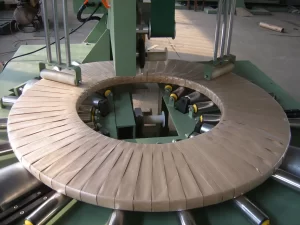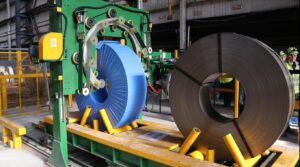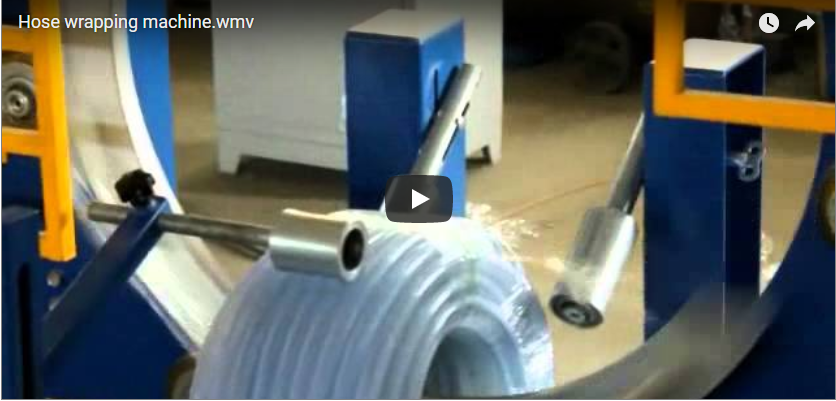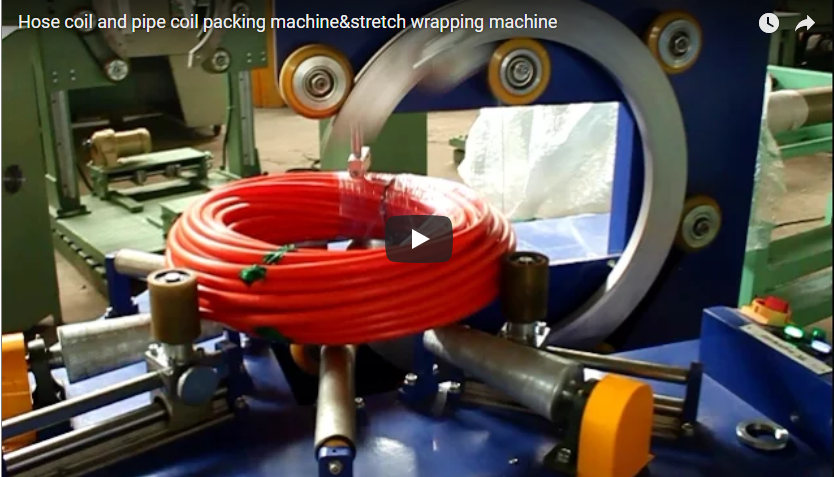This article delves into the technical specifications, design considerations, operational advantages, and user experience of a Semi-automatic Horizontal Coil Wrapping Machine, specifically engineered for securely packaging cable coils, hose coils, wire coils, and similar products using materials like stretch film, woven bags, or VCI paper. Designed for industrial environments, this machine enhances packaging efficiency and product protection.
1. Operational Principle and Design Philosophy
The Semi-auto Horizontal Coil Wrapping Machine operates by passing the coil horizontally through a rotating wrapping ring. This ring carries the packaging material (e.g., stretch film, VCI paper, woven fabric), applying it circumferentially around the coil as it traverses the machine or while stationary, depending on the specific operational mode.
Design Considerations:
- Horizontal Orientation: Facilitates easy loading and unloading of heavy or unwieldy coils, often integrating seamlessly with roller conveyors. This orientation provides stability during the wrapping process, crucial for maintaining consistent wrap quality on large-diameter products.
- Semi-Automatic Control: Balances automation with operator oversight. Key automated functions include ring rotation, material feeding, and cutting, while coil loading, positioning, and cycle initiation typically require operator input. This approach offers a cost-effective solution compared to fully automatic systems while significantly improving upon manual wrapping.
- Structural Integrity: Built using robust materials, typically featuring a heavy-gauge steel frame, to withstand demanding industrial conditions and ensure longevity. Components are selected for durability and reliability in continuous operation.
- Flexibility: Designed to accommodate a range of coil sizes (diameter and width) and utilize various wrapping materials, enhancing its applicability across different industries.

copper coil wrapper2 2. Key Components and Systems Breakdown
Understanding the core components provides insight into the machine's functionality and performance capabilities:
- Wrapping Ring Assembly:
- Ring Structure: Typically fabricated from steel or aluminum, precision-machined for smooth rotation.
- Drive System: Often utilizes a reliable belt or chain drive connected to an electric motor with variable speed control, allowing adjustment of the wrapping overlap and speed. Ring rotation speeds can range, impacting cycle time (e.g., 60-120 RPM depending on size and balance).
- Conveyor/Support System:
- Rollers: Equipped with driven or non-driven rollers (polyurethane-coated or steel) to support and sometimes rotate the coil during wrapping. Load capacities are designed based on expected coil weights (e.g., up to 1500 kg).
- Alignment Guides: Adjustable side guides ensure proper coil positioning relative to the wrapping ring.
- Control System:
- PLC (Programmable Logic Controller): The central brain (e.g., Siemens, Allen-Bradley, Omron) manages machine sequences, timings, and functions based on user settings.
- HMI (Human-Machine Interface): Typically a touchscreen display allowing operators to set parameters (wrap counts, overlap percentage, tension), monitor status, and perform diagnostics.
- Sensors: Photoelectric or proximity sensors detect coil presence and position, ensuring accurate start/stop of the wrapping cycle.
- Wrapping Material Dispenser:
- Tension Control: Critical for optimal material usage and wrap security. Mechanisms can range from simple mechanical friction brakes to sophisticated motorized pre-stretch systems (for stretch film, achieving up to 250-300% stretch). Adjustable tension ensures suitability for delicate products or tight wraps.
- Roll Carriage: Designed for easy loading of material rolls (specifying core diameter, max OD, and width).
- Cutting and Clamping Unit:
- Mechanism: Automated unit, often pneumatically or electrically actuated, that clamps the leading edge of the material at the start and cuts the material cleanly at the cycle's end.
3. Technical Specifications Overview
The following parameters provide a general guide. Note: These specifications may not perfectly match the machine shown in the video; please contact us for precise configurations tailored to your application.
- Machine Type: Semi-Automatic Horizontal Orbital Wrapper
- Coil Compatibility:
- Outer Diameter (OD): 500 - 1200 mm (Typical range, customizable)
- Inner Diameter (ID): 300 - 800 mm (Typical range, customizable)
- Width: 100 - 500 mm (Typical range, customizable)
- Max Weight: Up to 1000 kg (Varies by model)
- Wrapping Materials: LLDPE Stretch Film, VCI Paper, Woven Fabric, Crepe Paper, HDPE Film
- Material Roll Specifications:
- Width: 100 - 500 mm
- Core Diameter: 76 mm (Standard)
- Max Outer Diameter: Up to 500 mm
- Operational Parameters:
- Ring Speed: 60 - 100 RPM (Adjustable)
- Conveyor Speed: Approx. 3 - 9 m/min (Adjustable, if applicable)
- Overlap Rate: 10% - 90% (Adjustable via PLC/HMI)
- Wrapping Cycle Time: 20 - 60 seconds per coil (Dependent on coil size and wrap layers)
- Control System: PLC with Touchscreen HMI
- Power Requirements: 380V/50Hz/3-Phase (Or per customer specification)
- Compressed Air: 0.5 - 0.7 MPa (If pneumatic components are used)
- Construction: Heavy-duty steel frame, durable powder-coated finish
- Safety Features: Emergency stop buttons, safety guarding around rotating parts, interlocks.
4. Material Handling and Wrapping Process
The typical operational workflow for a semi-automatic horizontal wrapper involves:
- Coil Loading: The operator places the coil onto the infeed conveyor or directly onto the support rollers using lifting equipment (e.g., crane, forklift, C-hook).
- Positioning: The coil is moved into the wrapping position, often centered within the ring path using alignment guides.
- Cycle Initiation: The operator selects the wrapping program/parameters on the HMI and initiates the cycle via a start button.
- Automated Wrapping: The ring rotates, applying the wrapping material. If conveyors are driven, the coil may move axially through the ring. The PLC controls the number of wraps, overlap, and tension.
- Material Cut & Clamp: Upon cycle completion, the automated unit clamps and cuts the wrapping material.
- Coil Unloading: The operator moves the wrapped coil off the machine via the outfeed conveyor or lifting device.
The semi-automatic nature requires operator involvement for loading, unloading, and cycle start, making it suitable for operations with moderate throughput requirements or variable product types.

5. Customization and Optional Features
To meet specific application needs, these machines often offer customization options:
- Conveyor Modifications: Powered/non-powered rollers, belt conveyors, specific lengths.
- Top Press Device: Pneumatic or hydraulic platen to stabilize tall or unstable coils during wrapping.
- Integration: Ability to integrate with existing production lines, scales, or labeling systems.
- Safety Enhancements: Light curtains, safety fencing, area scanners.
- Special Environment Modifications: Stainless steel construction for food/pharma, explosion-proofing for hazardous areas.
6. Applications and Industry Benefits
The versatility of the Semi-auto Horizontal Coil Wrapping Machine makes it valuable across various sectors:
- Wire and Cable Manufacturing: Provides robust protection for spools and coils of electrical wire, fiber optic cable, and communication cables against dust, moisture, and transit damage. Ensures coils remain tightly wound.
- Steel and Metals Industry: Wraps coils of steel wire, aluminum wire, copper strips, and small steel coils, often using VCI paper or film to prevent corrosion during storage and shipping. Learn more about VCI technology here.
- Hose and Tube Production: Secures coils of industrial rubber hoses, hydraulic hoses, plastic tubing, and pipes, preventing uncoiling and protecting surfaces from abrasion. The consistent tension is key for maintaining coil shape.
- Plastics and Rubber Industry: Used for packaging various coiled extruded profiles, gaskets, or belts, providing containment and protection.
7. Advantages and User Experience Considerations
Key Advantages:
- Improved Packaging Efficiency: Significantly faster than manual wrapping, reducing labor costs and increasing throughput (e.g., wrapping a coil in under 60 seconds vs. several minutes manually).
- Enhanced Product Protection: Consistent, tight wrapping shields products from environmental factors (dirt, moisture, UV) and handling damage. Reduces product returns due to transit damage.
- Material Savings: Optimized tension control and pre-stretch capabilities (for stretch film) minimize material consumption compared to manual methods. Precise overlap control avoids waste.
- Operator Safety: Reduces manual handling strain and risks associated with manually maneuvering large rolls of wrapping material around heavy coils. Automated cutting eliminates manual blade use.
- Flexibility: Adaptable to different coil sizes and wrapping materials with relatively quick changeovers.
User Experience & Considerations:
- Ease of Use: Modern PLC/HMI interfaces are generally intuitive, allowing straightforward parameter adjustments and program selection.
- Training: Operators require basic training on machine operation, safety procedures, and material roll changes.
- Maintenance: Regular maintenance includes lubrication of moving parts (bearings, chains), sensor cleaning, blade sharpness checks, and inspection of pneumatic/electrical systems. Access panels are typically provided for maintenance tasks.
- Setup Time: Adjusting guides and potentially wrapping parameters when switching between significantly different coil sizes requires some setup time.
For further information or to discuss specific application requirements for semi-automatic horizontal coil wrapping solutions, please contact us.
www.fhopepack.com
coiler@fhopepack.com






